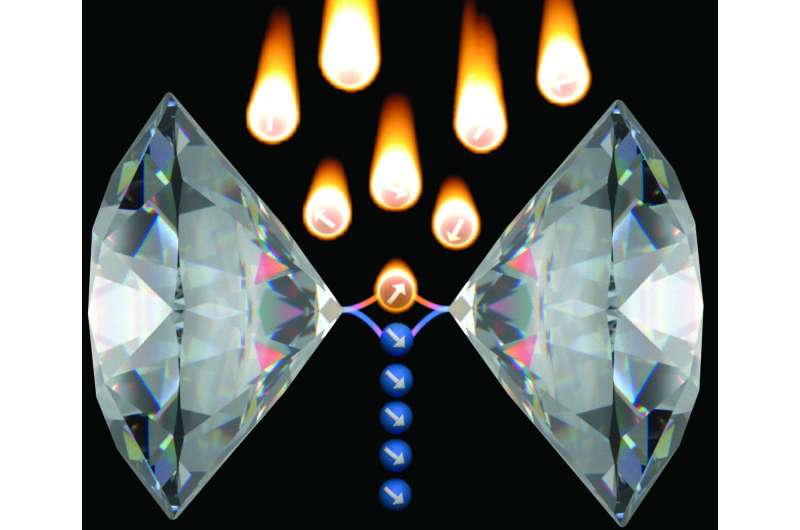Towards greater MRI sensitivity by harnessing quantum hyperpolarization

Researchers at the University of Melbourne have developed a technique which could increase the sensitivity of magnetic resonance imaging (MRI) for patient diagnosis.
The new technique works by increasing the strength of the magnetic field produced by molecules, and hence increasing their signal when measured by MRI.
The team engineered specific defects in diamond crystals that exert a controlled quantum mechanical influence over the nuclear spins in nearby molecules, including potentially those used in metabolic imaging of brain tumours, making them 'line up' (polarise) in a specific orientation.
This hyperpolarised state of nuclear spins is highly ordered and increases the magnetic field that can be detected by techniques like MRI.
It is the first time that this polarisation of molecular nuclei has been shown using such a diamond-based quantum probe.
University of Melbourne School of Physics researcher Professor Lloyd Hollenberg led the research team, with the work published in Nature Communications.
Professor Hollenberg, who is CQC2T Deputy Director and Thomas Baker Chair at the University of Melbourne, said the best MRI scanners in the world are now reaching the maximum magnetic field that can be tolerated by the human body as the technology strives for greater sensitivity.
"The superconducting magnets that produce these fields are also the reason MRI scanners cost millions of dollars, as the magnets need to be kept at cryogenic temperatures," Professor Hollenberg said.
"Clearly a disruptive approach is needed, so we look to using quantum technology to produce a greater signal intensity of certain molecular targets at the atomic level."
University of Melbourne PhD candidate David Broadway said the technique worked using a fridge magnet and a bit of atomic level quantum mechanics.
"We can think of the atom's nuclei like a compass needle that produces a magnetic field that depends on its orientation," Mr Broadway said.
"When there are several compass needles pointing in different directions, the resulting field tends to average to zero, but when the compasses point all in the same direction the contributions to the field from each compass needle will add up to something measurable," he said.
"So having the nuclei all lined up makes the magnetic field stronger and therefore the MRI reading it can pick up more detail.
"Currently, MRI's can get about one in a million nuclear spins to line up, whereas our method could achieve nearly 100 percent to line up within molecules, potentially enhancing the imaging sensitivity by orders of magnitude."
The modified diamonds could be used to construct a "quantum hyperpolarisation" chip, over which a target molecular contrast agent could be flowed. The quantum mechanical interaction between target and quantum probes is harnessed to transfer the polarisation from the diamond to the agent, which could be injected into, or inhaled by, a patient prior to their MRI. The agent retains its polarisation long enough to, for example, travel to a tumour site, making it easier to image through MRI.
Postdoctoral researcher Dr Liam Hall said MRI-based precision medicine already employs this type of imaging, but the cost of the infrastructure required can rival that of the MRI scanners themselves.
"Additionally, we would only use light shone through diamonds in the quantum mechanical production of polarised contrast agents already approved for routine use. So nothing toxic would enter the body," Dr Hall said.
"The technique came out of our work in developing quantum sensing technology, and the realisation that these diamond-based quantum probes can exert a powerful influence on surrounding nuclear spins when we optimise the conditions under which they directly "talk" to eachother", said Dr Hall, who came up with the theoretical concept.
"In a sense, the quantum probe extracts random spin disorder from the ('hot') target molecule to produce an ordered ('cold') spin-aligned state. The potential for application in hyperpolarisation for MRI soon became clear."
The power of the quantum technique is manifest from the experimental demonstration.
Professor Hollenberg said: "To put it in context, to achieve the same level of polarisation with a conventional approach, we'd need to increase the magnetic field by a factor of about 100,000 times, and you're only going to find fields like that in a neutron star."
Techniques for hyperpolarising nuclear spins could have a number of important applications in the physical and life sciences.
Hyperpolarised metabolites can be injected into patients and will travel to tumour sites and where they can be monitored in real-time using MRI as they're metabolised; and hyperpolarised gases can be inhaled for MRI imaging of lungs and their function. Both of these techniques have central roles to play in the dawning era of personalised medicine.
Hyperpolarisation of target molecules also increases to signal to noise ratio of high-resolution Nuclear Magnetic resonance (NMR) spectroscopy, making it an important tool for studying complex biomolecular systems.
"Clearly the next step, which we are heavily focused on, is to repeat this process using macroscopically sized engineered arrays of these quantum probes in diamond to scale this technology up," Professor Hollenberg said.
"More probes equals more polarisation and more contrast agent molecules produced, but the probes start to upset each other quantum mechanically if they are packed in too closely, so we need to find the right balance,.
"If we can tick that box, we can then think about polarising volumes of MRI contrast agents that are detectable by the MRI scanners found in research labs and hospitals."
More information: Nature Communications (2018). DOI: 10.1038/s41467-018-03578-1
Journal information: Nature Communications
Provided by University of Melbourne




















